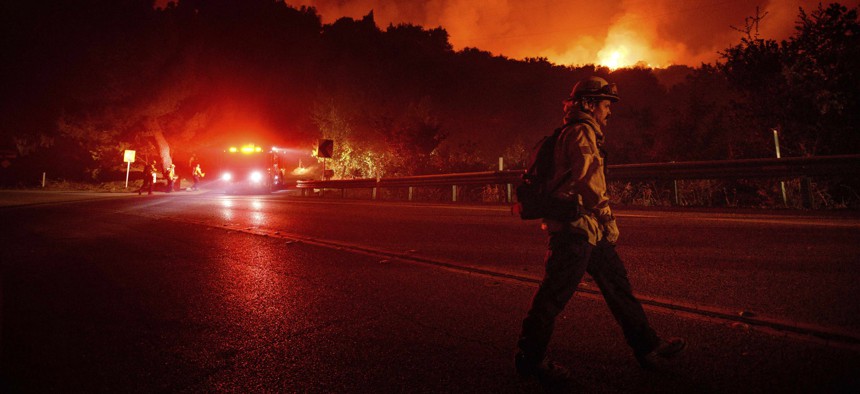Fighting Wildfire With Fire: New Study Looks at Barriers to ‘Prescribed’ Burns

A firefighter crosses Highway 154 while battling the Cave Fire in Los Padres National Forest, Calif., above Santa Barbara on Tuesday, Nov. 26, 2019. AP Photo/Noah Berger
Researchers say that millions of acres of California forest is in need of preventative measures to help lower wildfire risks.
There are roughly 20 million acres of forest in California—nearly one-fifth of the state’s land—where controlled burns and other measures to thin out vegetation, could help reduce the risk of massive wildfires, according to a new academic study.
The paper, published this week in Nature Sustainability, looks at some of the reasons why “prescribed burns” aren’t taking place on a wider scale in the state. The research involved an analysis of state legislation, prescribed burn records, and transcripts of interviews with 45 people who are familiar with wildfire policy issues in California.
“We need a colossal expansion of fuel treatments,” the study’s lead author Rebecca Miller, who is a PhD student at Stanford, said in a statement, referring to practices like the controlled burns.
California has dealt with some especially catastrophic wildfires in recent years. But the takeaways from the paper could possibly be applied to places outside of the state. In California, private landowners, state agencies and federal authorities can each conduct prescribed burns, but are supposed to follow certain requirements.
The researchers found that barriers to planning and carrying out the burns tend to fall into three main categories: risks, resource limitations, and regulations.
On the risk front, whoever sets the fires can be held liable if the flames get out of control and cause unanticipated damage. This can make both private landowners and government officials wary of conducting the burns. Federal land managers can face punishment if burns go wrong, but typically get few rewards if they go right, interviewees noted, according to the paper.
The limited availability of crews that are qualified to conduct the burns is another difficulty that the interviewees identified. Before 2018, the paper says, California did not have prescribed burn training or certification programs. And wildfire fighting crews are often hired for the height of wildfire season, which is not typically the best time to assign them to controlled burn projects.
Regulations come into play with processes like environmental reviews for burns carried out by parties that receive state or federal funds. The reviews can be costly and time consuming.
Concerns and regulations that have to do with the smoke from prescribed burns can also present obstacles. Some land managers reportedly blame the boards that oversee air quality in California for not allowing enough “burn days.” Board officials dispute that claim.
The paper suggests that executing successful prescribed burns could build more public support for the practice. The backing of high profile public officials could also help, as could dedicated funding and other steps, like greater standardization across the air boards.
In addition to prescribed burns there are other techniques to cut down on wildfire risks.
With “mechanical thinning,” workers use machines and hand tools to clear out alive and dead vegetation that’s low to the forest floor. These plants and smaller trees can act like ladders, enabling wildfire flames to climb into the tops of bigger trees, setting them ablaze.
Some interviewees acknowledged that there can be little appeal for timber companies to harvest this type of vegetation because it is worth little. Others criticized the logging industry for sometimes leaving smaller, more flammable vegetation after cutting down larger trees.
While mechanical thinning can be helpful in curbing wildfire risk, it is best conducted along with prescribed burns, according to the paper.
“Prescribed burns are effective and safe,” one of the study’s co-authors, Chris Field, a Stanford professor and director of the Stanford Woods Institute for the Environment, said in a statement.
“California needs to remove obstacles to their use so we can avoid more devastating wildfires,” he added.
Bill Lucia is a Senior Reporter for Route Fifty and is based in Olympia, Washington.
NEXT STORY: Proposed Missouri Bill Targeting Children’s Books Could Land Librarians in Jail






